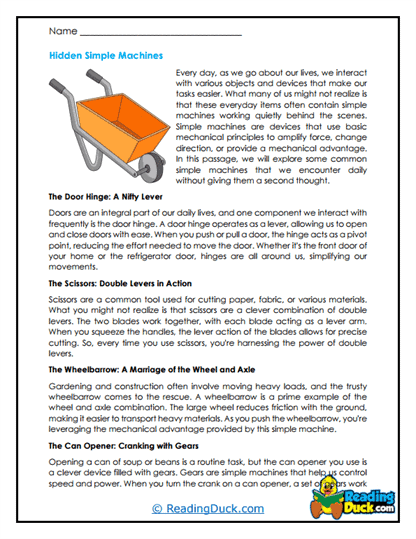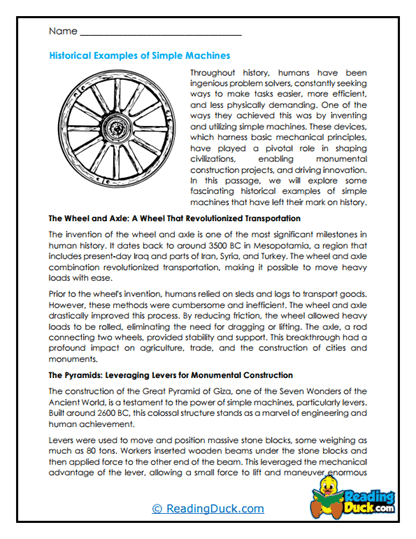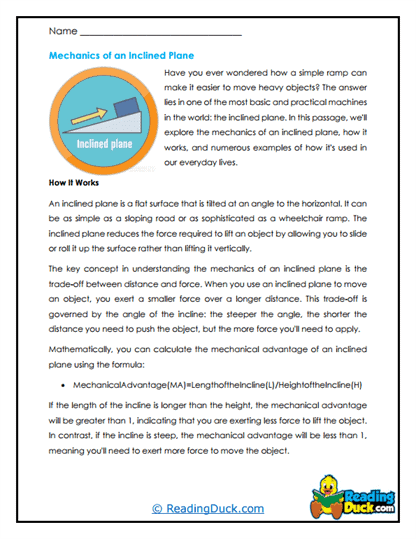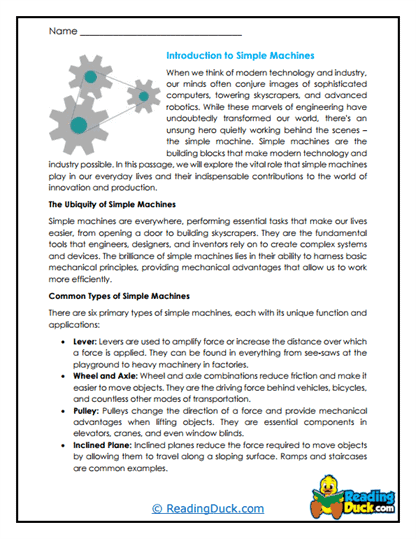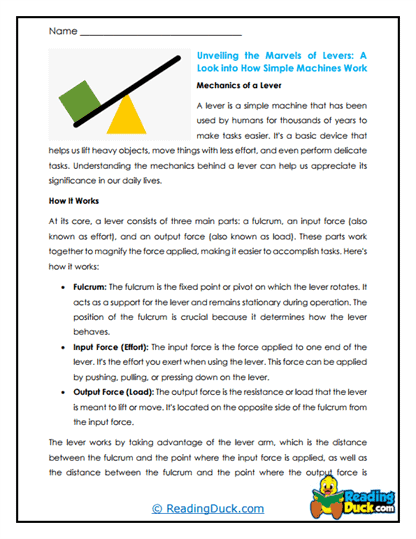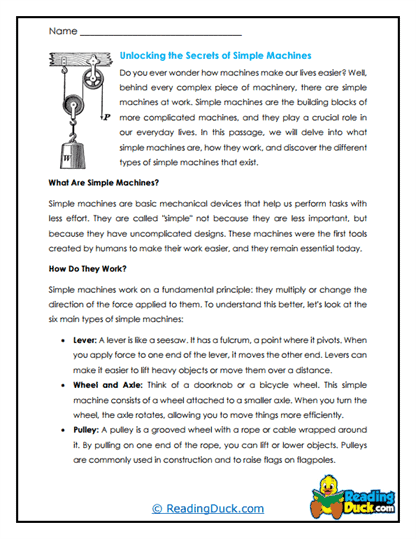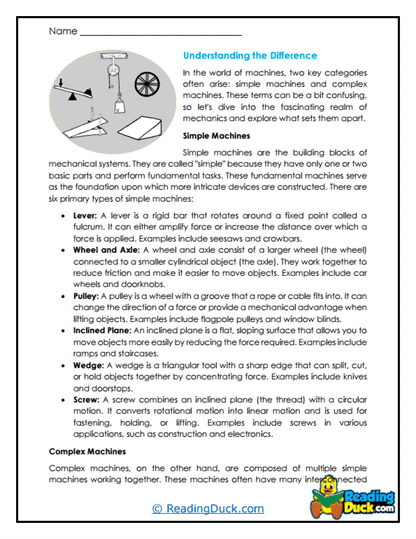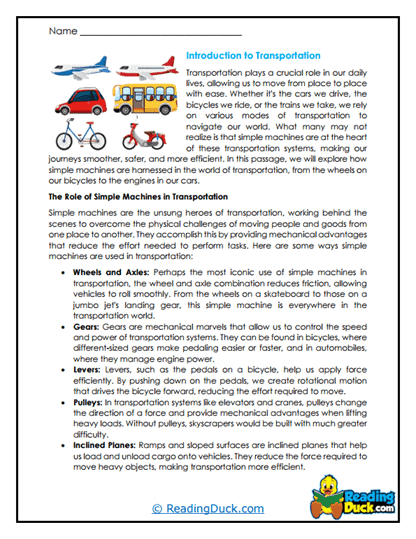Simple Machines Worksheets
About Our Simple Machines Worksheets
Our Simple Machines worksheets are designed to give students a solid understanding of the fundamental concepts behind simple machines, which are the building blocks of more complex devices in physics and engineering. These worksheets are a subtopic of Physics, focusing on how simple machines make work easier by allowing us to apply less force over greater distances. This collection offers a comprehensive exploration of levers, pulleys, inclined planes, screws, wedges, and wheels and axles.
Each worksheet set includes:
- Multiple Choice Questions: These questions test students’ comprehension of the key concepts presented in the reading passage, ensuring they understand the basic principles and applications of each type of simple machine.
- Short Answer Questions: These prompts encourage students to explain concepts in their own words, fostering a deeper understanding and helping them articulate their knowledge clearly.
- Open-Ended Questions: These questions invite students to reflect on the material, express their own opinions, and connect the concepts to real-world scenarios, enhancing their critical thinking and personal engagement with the topic.
Answer keys are provided for all question sheets, making it easier for teachers and parents to guide students through the material. The worksheets are available as PDF files, which can be viewed electronically, downloaded, and printed out for convenient use in any educational setting.
Understanding Simple Machines: The Basics of Physics and Engineering
Simple machines are devices that make our lives easier by allowing us to perform tasks with less effort. They form the foundation of many tools and machines that we use every day. By understanding simple machines, students can learn how these fundamental principles are applied in various aspects of engineering, construction, and everyday life. Let's explore the key concepts behind each type of simple machine.
1. Levers: A Balancing Act
- What is a Lever?
- A lever is a rigid bar that rotates around a fixed point known as the fulcrum. Levers allow us to lift heavy loads with less effort by applying force at a greater distance from the fulcrum.
- Types of Levers:
- Levers are categorized into three classes based on the position of the fulcrum, load, and effort.
- First-Class Levers: The fulcrum is between the load and the effort (e.g., seesaws, crowbars).
- Second-Class Levers: The load is between the fulcrum and the effort (e.g., wheelbarrows, nutcrackers).
- Third-Class Levers: The effort is applied between the fulcrum and the load (e.g., tweezers, fishing rods).
- Levers are categorized into three classes based on the position of the fulcrum, load, and effort.
- Real-World Applications:
- Levers are used in many tools and devices, from simple scissors to complex lifting mechanisms. Understanding how levers work helps students grasp the concept of mechanical advantage, which is how much a machine multiplies the input force.
2. Pulleys: Lifting with Ease
- What is a Pulley?
- A pulley is a wheel with a groove around its edge, through which a rope or cable can run. Pulleys make it easier to lift heavy objects by changing the direction of the force applied.
- Types of Pulleys:
- Pulleys can be fixed, movable, or compound:
- Fixed Pulleys: These pulleys are attached to a fixed point and only change the direction of the force (e.g., flagpoles).
- Movable Pulleys: These pulleys move with the load, reducing the amount of force needed to lift the load (e.g., construction cranes).
- Compound Pulleys: These systems combine fixed and movable pulleys to further reduce the effort needed to lift heavy loads (e.g., block and tackle systems).
- Pulleys can be fixed, movable, or compound:
- Real-World Applications:
- Pulleys are used in a variety of settings, from construction sites to theatre stages, where heavy curtains are lifted with ease. Learning about pulleys helps students understand how simple devices can make tasks that seem impossible achievable with minimal effort.
3. Inclined Planes: Making the Climb Easier
- What is an Inclined Plane?
- An inclined plane is a flat surface tilted at an angle, used to help move objects from a lower to a higher elevation with less force than lifting directly.
- How Inclined Planes Work:
- By extending the distance over which the force is applied, inclined planes reduce the amount of force needed to move an object upwards. The steeper the incline, the more force is needed, but the less distance the object has to travel.
- Real-World Applications:
- Inclined planes are found in ramps, slides, and even screws. Understanding how inclined planes work allows students to appreciate how these simple machines are used in accessibility features, construction, and everyday life.
4. Screws: Twisting for Power
- What is a Screw?
- A screw is essentially an inclined plane wrapped around a cylinder. It converts rotational force into linear motion, allowing objects to be held together or lifted with ease.
- How Screws Work:
- The threads of a screw create a continuous inclined plane, which allows for a gradual application of force. The finer the threads, the less force is needed to turn the screw, but more turns are required.
- Real-World Applications:
- Screws are used in everything from construction (fastening materials together) to machinery (moving objects or liquids). By studying screws, students learn about the relationship between force and motion in practical applications.
5. Wedges: Splitting and Cutting
- What is a Wedge?
- A wedge is a triangular-shaped tool that is used to split, cut, or lift objects. It works by concentrating force on a small area, allowing it to easily penetrate or lift materials.
- How Wedges Work:
- Wedges work by converting force applied to the blunt end into a force that pushes outwards on both sides of the sharp edge. This makes it easier to split or cut materials.
- Real-World Applications:
- Wedges are used in tools like axes, knives, and chisels. Understanding how wedges work helps students see the importance of simple machines in everyday tools that require precision and strength.
6. Wheels and Axles: Rolling with Less Resistance
- What is a Wheel and Axle?
- A wheel and axle is a simple machine that consists of a larger wheel attached to a smaller axle. When force is applied to the wheel, it turns the axle, making it easier to move objects over a distance.
- How Wheels and Axles Work:
- The larger the wheel, the less force is needed to turn the axle. This principle is used in everything from rolling carts to complex machinery, where reducing friction and effort is key.
- Real-World Applications:
- Wheels and axles are used in transportation, machinery, and even in household items like doorknobs and rolling chairs. Learning about wheels and axles helps students understand how simple machines contribute to the efficiency of movement in various contexts.
Activities to Supplement These Worksheets
To deepen students’ understanding and engagement with simple machines, here are some hands-on activities that teachers and parents can incorporate alongside these worksheets:
1. Building a Lever
- Objective: Understand how levers work and explore the concept of mechanical advantage.
- Activity: Provide students with a ruler, a small object (like a block or eraser), and a fulcrum (such as a pencil). Have them experiment by placing the fulcrum at different points under the ruler and lifting the object. This activity helps students visualize how the position of the fulcrum affects the effort needed to lift the object.
2. Creating a Pulley System
- Objective: Learn how pulleys reduce the effort needed to lift objects.
- Activity: Using string, a small weight, and a spool or pulley wheel, students can create their own pulley systems. They can experiment with different configurations to see how the number of pulleys affects the amount of force needed to lift the weight.
3. Designing an Inclined Plane
- Objective: Explore how inclined planes reduce the effort needed to move objects.
- Activity: Students can create an inclined plane using cardboard and a small object like a toy car. By adjusting the angle of the incline, they can observe how the steepness affects the force needed to move the object upwards.
4. Making a Simple Screw
- Objective: Understand the mechanics of a screw and its applications.
- Activity: Students can wrap a strip of paper around a pencil to create a simple screw model. They can then experiment by “drilling” the paper screw into a piece of styrofoam, observing how the inclined plane helps the screw move into the material with less effort.
5. Experimenting with Wedges
- Objective: Demonstrate how wedges work to split or cut materials.
- Activity: Provide students with a wedge-shaped object (like a plastic knife) and a piece of soft material (like clay or fruit). Have them use the wedge to cut or split the material, observing how the shape of the wedge makes it easier to separate the material with minimal force.
6. Constructing a Wheel and Axle
- Objective: Explore how wheels and axles reduce friction and make movement easier.
- Activity: Students can create a simple wheel and axle system using cardboard discs and a dowel rod. By rolling the system across different surfaces, they can observe how the wheel and axle make movement smoother and require less force compared to dragging the object directly.
7. Simple Machines Scavenger Hunt
- Objective: Identify simple machines in everyday life.
- Activity: Challenge students to find examples of simple machines in their homes or classrooms. They can create a list or take photos of the machines they find, categorizing them into levers, pulleys, inclined planes, screws, wedges, and wheels and axles.
Significance of Studying Simple Machines
Understanding simple machines is essential for students as it provides the foundation for learning about more complex machines and engineering concepts. These worksheets and activities help students develop problem-solving skills, enhance their understanding of physical principles, and foster an appreciation for how science and engineering shape the world around them. Engaging with simple machines also encourages curiosity and innovation, as students realize the impact of these basic tools in everyday life and in technological advancements.
